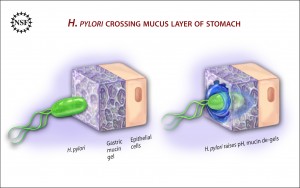Bacteria Motility
Professors Rama Bansil and Shyam Erramilli, research fellow at Harvard/MGH and former graduate student Jonathan Celli, and collaborators from Harvard Medical School and MIT, have uncovered the process by which H. Pylori bacteria are able to move through the mucus lining in our stomachs, causing ulcers and even cancer.
Their study, which utilizes optical microscopy and rheology, indicates that the helicoidal-shaped H. pylori does not bore its way through the mucus gel like a screw through a cork as was previously suggested.
Instead it achieves motility by secreting the enzyme urease to produce ammonia, the same biochemical strategy it uses to survive in the stomach’s acidic environment. The ammonia changes the mucin in the mucus layer from a gel to a liquid so that the bacteria can swim across the barrier.
The findings were published in the Proceedings of the National Academy of Sciences and were highlighted in a video by the National Science Foundation featuring Bansil and Celli. The results could have implications for the prevention and treatment of H. Pylori infections.
Image credit: Zina Deretsky, National Science Foundation
Continue reading: Computational Physics of Phase Transitions
Return to Research
 Physics | Annual Report 2010
Physics | Annual Report 2010 